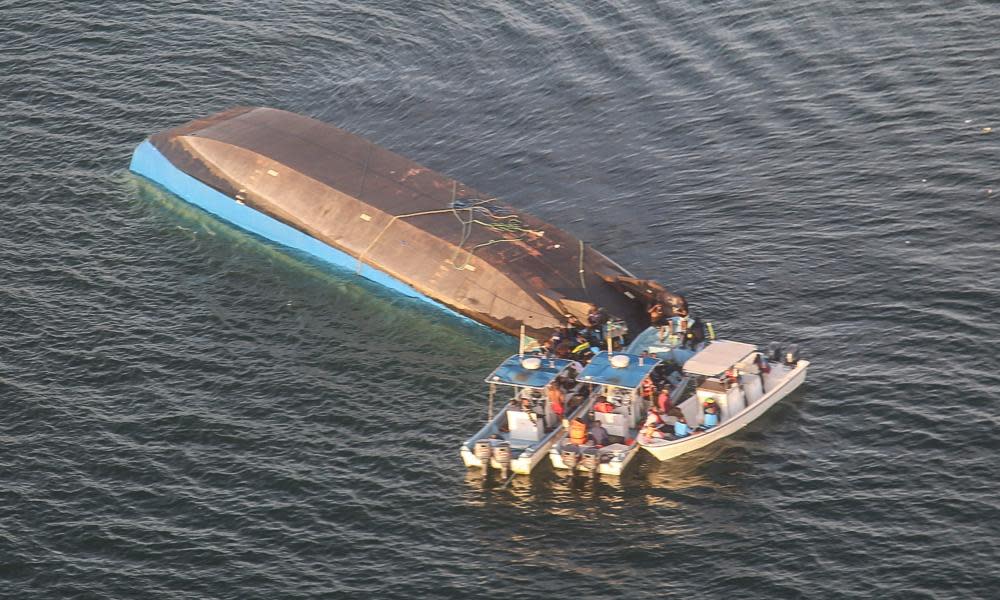Tanzania ferry disaster: divers pull survivor from capsized ship

Grieving families were on Sunday preparing to bury victims of Tanzania’s devastating ferry disaster, with more than 200 confirmed dead after the crowded boat capsized in Lake Victoria.
Hopes were fading of finding any more survivors three days after the ferry sank, even after rescuers pulled out an engineer who had managed to find refuge in an air pocket in the upturned vessel. The Tanzanian broadcasting corporation reported he had shut himself in the engine room.
“We are going to start burying bodies not yet identified by relatives,” said John Mongella, governor of Mwanza region, where the MV Nyerere ferry had been coming in to dock on the island of Ukara.
“The (burial) ceremony will be overseen by Prime Minister Kassim Majaliwa, in the presence of clergy members of different denominations,” Mongella Told TBC 1 public television.
Mongella said 218 people had been confirmed dead, while 41 escaped the tragedy with their lives – a total figure far above the official capacity of the boat, which was in theory only able to carry 101 passengers.
Transport Minister Isack Kamwelwe said on Saturday that 172 of the victim’s bodies had been identified by relatives.
Navy divers resumed the search operation inside the sunken MV Nyerere early on Saturday after hearing sounds that suggested signs of life. They pulled a man out of the overturned ship and he was taken to hospital, a witness said, while bodies continued to float to the surface around the vessel.
Tanzania’s president, John Magufuli, has ordered the arrest of the managers of the ferry, which may have been carrying as many as 300 people when it capsized near the dock on the Ukara Island. The precise number was unknown, however, because the ticket-seller had drowned and the machine recording sales had not been found.
During a speech on public television on Friday night, Magufuli referred to negligence and said he had ordered the arrest of all those involved in the management of the ferry. “It appears clear that the ferry was overloaded,” he said, adding that the arrests had already begun.
The president also declared four days of national mourning.
The works, transport and communication minister, Isack Kamwelwe, said the government was sending sophisticated equipment to aid the rescue. “This equipment will increase efficiency in the rescue operation and we will continue with the search until we are satisfied that we have rescued everyone,” he told Reuters. At least 40 people were brought to safety on Thursday as dozens of security forces and volunteers wearing gloves and face masks spent the day hauling bodies into wooden boats.
Tanzanian ferries often carry hundreds of passengers and are overcrowded, and there are shifts in weight as passengers move to disembark. The Nyerere was crowded because it was a market day.
Domina Maua, who was among those at the dockside seeking information about survivors on Friday, said she had not heard from either her father or her younger brother who were on the ferry on a trip to buy a school uniform and other supplies for the new school term.
The son of Davita Ngenda, an older woman in Ukara, was among the dead. “He had gone with his wife but she has not been found yet. My God, what did I do to deserve this?” she said.
The ageing ferry, of which the hull and propellers were all that remained visible, was also carrying cargo, including sacks of maize, bananas and cement, when it capsized about 50 metres from Ukara dock. The cause of the accident was not immediately clear, but overloading is frequently to blame for such incidents.
The country’s opposition, however, accused the government of negligence. “We have often raised concerns about the poor condition of this ferry, but the government turned a deaf ear. We have repeatedly denounced this negligence,” said John Mnyika, the deputy secretary general of Chadema, the main opposition party.
Mnyika said overloading was “another failure of the authorities” and criticised “inadequate relief efforts as well as delays” in the rescue operation.
With a surface area of 70,000 sq km (27,000 sq miles), the oval-shaped Lake Victoria is shared by Tanzania, Uganda and Kenya. Capsizes are not uncommon and the number of deaths is often high because of a shortage of lifejackets and the fact that many people in the region cannot swim.
The deadliest such incident in recent decades was in May 1996, when about 800 people died after their ferry sank on the way to Mwanza in Tanzania. Lake Victoria’s waters can be rough and boats are frequently poorly maintained, while ferry operators often fail to record the number of passengers on board.
About 20 people were killed in December 2016 when a boat overturned on the lake as it was carrying passengers to mainland Uganda for the Christmas holidays.
In March 2012, only two survivors were found after a boat carrying about 60 people capsized on the lake in Uganda.

 Yahoo News
Yahoo News 